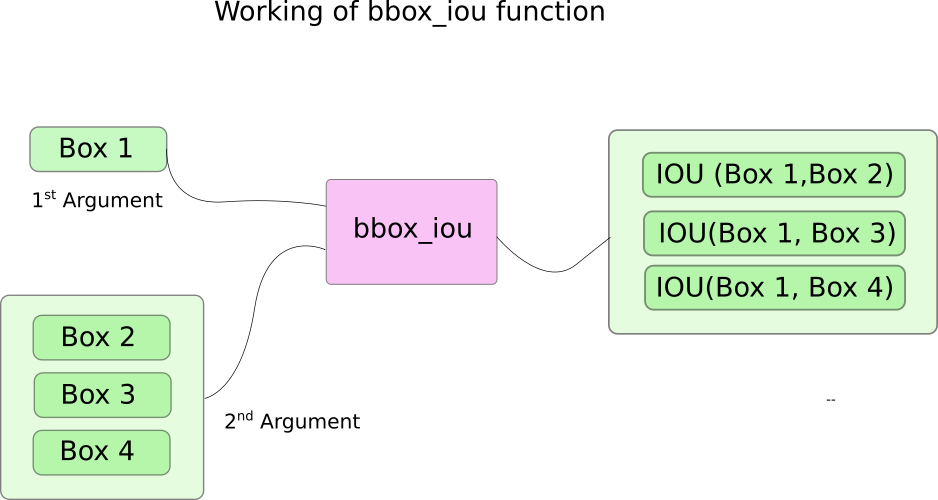Pytorch从0开始实现YOLO V3指南 part4——置信度阈值和非极大值抑制
前一节我们实现了网络的前向传播。这一节我们对检测输出设置目标置信度阈值和进行非极大值抑制。
必要条件:
1.此系列教程的Part1到Part3。
2.Pytorch的基本知识,包括如何使用nn.Module,nn.Sequential,torch.nn.parameter类构建常规的结构
3.numpy的基础知识
此前我们已经建立了一个模型,给定一张输入图片它能产生B*10674*85维的输出向量。B是批中图片的数目,10674是每张图片预测的边界框数目,85是边界框属性数目。
但就像我们在part1中描述的那样,我们必须对输出进行目标置信度阈值化和非极大值抑制,以获得最终剩余的真正检测。为此,我们将在文件util.py中创建一个名为write_results的函数。
def write_results(prediction, confidence, num_classes, nms_conf = 0.4):
这个函数将prediction、confidence(目标置信度阈值)、num_classes(在我们的示例中是80)和nms_conf (NMS IoU的阈值)作为输入。
目标置信度阈值:
我们的预测张量包含了关于B x 10647个边界框的信息。对于每个目标置信度低于阈值的边界框,我们将它的每个属性(行向量)的值设置为零。
conf_mask = (prediction[:,:,4] > confidence).float().unsqueeze(2)
prediction = prediction*conf_mask
执行极大值抑制:
我们现在拥有的是边界框的中心坐标以及高度和宽度,然而使用边界框的对角点更容易计算IOU。因此,我们将框的(center x, center y, height, width)属性转换为(左上角x,左上角y,右下角x,右下角y)。
box_corner = prediction.new(prediction.shape)
box_corner[:,:,0] = (prediction[:,:,0] - prediction[:,:,2]/2)
box_corner[:,:,1] = (prediction[:,:,1] - prediction[:,:,3]/2)
box_corner[:,:,2] = (prediction[:,:,0] + prediction[:,:,2]/2)
box_corner[:,:,3] = (prediction[:,:,1] + prediction[:,:,3]/2)
prediction[:,:,:4] = box_corner[:,:,:4]
每幅图像中真实检测框的数目可能不同。例如,一批大小为3的图像,其中图像1、2和3分别有5、2、4个真检测值。因此,每次必须对同一个图像进行置信阈值和NMS,而不能对所涉及的操作进行矢量化,必须在预测的第一个维度(包含成批图像的索引)上进行遍历操作。
batch_size = prediction.size(0) write = False for ind in range(batch_size):
image_pred = prediction[ind] #image Tensor
#confidence threshholding
#NMS
write标志位用于指示我们是否对output进行了初始化,将会使用一个向量来收集整个批中真实的预测。
循环的开始我们进行数据清理。因为每个边界框行有85个属性,其中80个是类得分。我们只关心类得分最大值的那个,所以会从每行中删除80个类得分,添加具有最大值的类的索引,以及该类的类得分。
max_conf, max_conf_score = torch.max(image_pred[:,5:5+ num_classes], 1)
max_conf = max_conf.float().unsqueeze(1)
max_conf_score = max_conf_score.float().unsqueeze(1)
seq = (image_pred[:,:5], max_conf, max_conf_score)
image_pred = torch.cat(seq, 1)
我们前面已经将目标置信度得分低于阈值的边界框行属性设置为了0,现在就筛除它们。
non_zero_ind = (torch.nonzero(image_pred[:,4]))
try:
image_pred_ = image_pred[non_zero_ind.squeeze(),:].view(-1,7)
except:
continue #For PyTorch 0.4 compatibility
#Since the above code with not raise exception for no detection
#as scalars are supported in PyTorch 0.4
if image_pred_.shape[0] == 0:
continue
try-except块用于处理没有检测到的情况。在这种情况下,我们使用continue跳过此图像的其余循环体。
接下来,让我们在图像中检测目标。
#Get the various classes detected in the image
img_classes = unique(image_pred_[:,-1]) # -1 index holds the class index
因为对于同一个类别可能存在多个正确检测,我们使用一个叫unique的函数来获得给定图片中所有出现的类。
def unique(tensor):
tensor_np = tensor.cpu().numpy()
unique_np = np.unique(tensor_np)
unique_tensor = torch.from_numpy(unique_np) tensor_res = tensor.new(unique_tensor.shape)
tensor_res.copy_(unique_tensor)
return tensor_res
之后我们对于每个类进行NMS
for cls in img_classes:
#perform NMS
一进入这个循环,首先要做的事情就是提取对于某一特定类别的检测(用变量cls表示)
#get the detections with one particular class
cls_mask = image_pred_*(image_pred_[:,-1] == cls).float().unsqueeze(1)
class_mask_ind = torch.nonzero(cls_mask[:,-2]).squeeze()
image_pred_class = image_pred_[class_mask_ind].view(-1,7) #sort the detections such that the entry with the maximum objectness
#confidence is at the top
conf_sort_index = torch.sort(image_pred_class[:,4], descending = True )[1]
image_pred_class = image_pred_class[conf_sort_index]
idx = image_pred_class.size(0) #Number of detections
然后我们进行NMS
for i in range(idx):
#Get the IOUs of all boxes that come after the one we are looking at
#in the loop
try:
ious = bbox_iou(image_pred_class[i].unsqueeze(0), image_pred_class[i+1:])
except ValueError:
break except IndexError:
break #Zero out all the detections that have IoU > treshhold
iou_mask = (ious < nms_conf).float().unsqueeze(1)
image_pred_class[i+1:] *= iou_mask #Remove the non-zero entries
non_zero_ind = torch.nonzero(image_pred_class[:,4]).squeeze()
image_pred_class = image_pred_class[non_zero_ind].view(-1,7)
这里我们使用到了一个函数bbox_iou。第一个输入参数是循环体变量i索引处的边界框,第二个输入参数是多行边界框的一个tensor。函数bbox_iou的输出是一个tensor它包含了第一个输入的边界框与第二个输入的所有边界框的IOU。如下:

之前我们已经将目标置信度高的边界框放在前面,如果后面的边界框IoU值与前面的相比超过了阈值,那后者就会被删去。
循环体里面下面这行计算IoU。
ious = bbox_iou(image_pred_class[i].unsqueeze(0), image_pred_class[i+1:])
每轮迭代,如果有任何索引大于i的边界框与第i个边界框的IoU大于阈值nms_thresh,那这个边界框就会被删除。
#Zero out all the detections that have IoU > treshhold
iou_mask = (ious < nms_conf).float().unsqueeze(1)
image_pred_class[i+1:] *= iou_mask #Remove the non-zero entries
non_zero_ind = torch.nonzero(image_pred_class[:,4]).squeeze()
image_pred_class = image_pred_class[non_zero_ind]
还要注意的是,我们将计算IoU的代码行放在try-catch块中。这是因为此循环按照id进行迭代(image_pred_class中的行数)。但因为我们循环过程中可能会从image_pred_class中删除一些边界框。这样一来,迭代可能会出现索引越界触发IndexError或者image_pred_class[i+1:]返回一个空张量触发ValueError。此时我们可以确定NMS已经无法删除多余的边界框了,从而跳出循环。
计算IoU:
def bbox_iou(box1, box2):
"""
Returns the IoU of two bounding boxes
"""
#Get the coordinates of bounding boxes
b1_x1, b1_y1, b1_x2, b1_y2 = box1[:,0], box1[:,1], box1[:,2], box1[:,3]
b2_x1, b2_y1, b2_x2, b2_y2 = box2[:,0], box2[:,1], box2[:,2], box2[:,3] #get the corrdinates of the intersection rectangle
inter_rect_x1 = torch.max(b1_x1, b2_x1)
inter_rect_y1 = torch.max(b1_y1, b2_y1)
inter_rect_x2 = torch.min(b1_x2, b2_x2)
inter_rect_y2 = torch.min(b1_y2, b2_y2) #Intersection area
inter_area = torch.clamp(inter_rect_x2 - inter_rect_x1 + 1, min=0) * torch.clamp(inter_rect_y2 - inter_rect_y1 + 1, min=0) #Union Area
b1_area = (b1_x2 - b1_x1 + 1)*(b1_y2 - b1_y1 + 1)
b2_area = (b2_x2 - b2_x1 + 1)*(b2_y2 - b2_y1 + 1) iou = inter_area / (b1_area + b2_area - inter_area) return iou
写入预测:
write_results函数输出一个形状为 Dx8 的tensor。这里D是所有图像的真实检测,每个都用一行表示。每个检测有8个属性,即检测所属批次图像的索引、4个角坐标、目标置信度得分、最大置信类得分、该类的索引。
和此前一样,我们等到有一个检测时才初始化输出向量并将后续的检测拼接进来。使用写标志来表示tensor是否已经初始化。在遍历类的循环结束时,我们将检测结果添加到输出tensor中。
batch_ind = image_pred_class.new(image_pred_class.size(0), 1).fill_(ind)
#Repeat the batch_id for as many detections of the class cls in the image
seq = batch_ind, image_pred_class if not write:
output = torch.cat(seq,1)
write = True
else:
out = torch.cat(seq,1)
output = torch.cat((output,out))
在函数的末尾,我们检查输出是否已经初始化。如果没有,就意味着这批图像中没有一个检测到。在这种情况下,我们返回0。
try:
return output
except:
return 0
这就是这一部分所要讲解的内容了。现在我们终于有了一个预测,它以tensor的形式列出了每一个边界框。所以只剩下一件事就是创建一个输入管道来从磁盘读取图像,计算预测,在图像上绘制边界框,然后显示/写入这些图像。这是我们下一部分要做的。
Further Reading
Pytorch从0开始实现YOLO V3指南 part4——置信度阈值和非极大值抑制的更多相关文章
- Pytorch从0开始实现YOLO V3指南 part1——理解YOLO的工作
本教程翻译自https://blog.paperspace.com/how-to-implement-a-yolo-object-detector-in-pytorch/ 视频展示:https://w ...
- Pytorch从0开始实现YOLO V3指南 part3——实现网络前向传播
本节翻译自:https://blog.paperspace.com/how-to-implement-a-yolo-v3-object-detector-from-scratch-in-pytorch ...
- Pytorch从0开始实现YOLO V3指南 part5——设计输入和输出的流程
本节翻译自:https://blog.paperspace.com/how-to-implement-a-yolo-v3-object-detector-from-scratch-in-pytorch ...
- Pytorch从0开始实现YOLO V3指南 part2——搭建网络结构层
本节翻译自:https://blog.paperspace.com/how-to-implement-a-yolo-v3-object-detector-from-scratch-in-pytorch ...
- [DeeplearningAI笔记]卷积神经网络3.6-3.9交并比/非极大值抑制/Anchor boxes/YOLO算法
4.3目标检测 觉得有用的话,欢迎一起讨论相互学习~Follow Me 3.6交并比intersection over union 交并比函数(loU)可以用来评价对象检测算法,可以被用来进一步改善对 ...
- pytorch实现yolov3(4) 非极大值抑制nms
在上一篇里我们实现了forward函数.得到了prediction.此时预测出了特别多的box以及各种class probability,现在我们要从中过滤出我们最终的预测box. 理解了yolov3 ...
- YOLO v3
yolo为you only look once. 是一个全卷积神经网络(FCN),它有75层卷积层,包含跳跃式传递和降采样,没有池化层,当stide=2时用做降采样. yolo的输出是一个特征映射(f ...
- 深度学习笔记(十三)YOLO V3 (Tensorflow)
[代码剖析] 推荐阅读! SSD 学习笔记 之前看了一遍 YOLO V3 的论文,写的挺有意思的,尴尬的是,我这鱼的记忆,看完就忘了 于是只能借助于代码,再看一遍细节了. 源码目录总览 tens ...
- 一文看懂YOLO v3
论文地址:https://pjreddie.com/media/files/papers/YOLOv3.pdf论文:YOLOv3: An Incremental Improvement YOLO系列的 ...
随机推荐
- Linux用命令设置终端背景色和字体颜色
用命令改 1.setterm -inversecreen on 背景字体颜色互换 2.setterm -inversecreen on 恢复默认 3.setterm -[选项] [参数] |-back ...
- .NET宝藏API之:IHostedService,后台任务执行
我们在项目开发的过程中可能会遇到类似后台定时任务的需求,比如消息队列的消费者. 按照.NetF时的开发习惯首先想到的肯定是Windows Service,拜托,都什么年代了还用Windows服务(小声 ...
- k8s入门之Service(六)
将一组pod公开为网络服务,通过service代理,可以实现负载均衡 一.ClusterIP 此方式只能在集群内访问 1.使用命令暴露已存在的pod (1)继续使用前面章节的案例,查看名称为nginx ...
- 全场景AI推理引擎MindSpore Lite, 助力HMS Core视频编辑服务打造更智能的剪辑体验
移动互联网的发展给人们的社交和娱乐方式带来了很大的改变,以vlog.短视频等为代表的新兴文化样态正受到越来越多人的青睐.同时,随着AI智能.美颜修图等功能在图像视频编辑App中的应用,促使视频编辑效率 ...
- Linux-进程工具
1.进程树 pstree pstree 可以用来显示进程的父子关系,以树形结构显示 格式: pstree [OPTION] [ PID | USER ] 常用选项: -p 显示PID -T 不显示线程 ...
- 20220303模拟赛题解and总结
目录 总结 A.不幸的7 B.选举 C. 差的绝对值之和 D. 路径通过 总结 初一第一 一般,最后一题没打好 不难发现,教练出水了,可能是信心赛 A.不幸的7 暴力,没有逻辑可言 #include& ...
- 解构HE2E中的Kubernetes技术应用
摘要:我们从Kubernetes技术应用的角度解构华为云DevCloud HE2E DevOps实践. 本文分享自华为云社区<解构HE2E中的Kubernetes技术应用>,作者: 敏捷小 ...
- 好客租房55-props深入(2props校验)
对于组件来说 props是外来的 无法保证使用者传入什么格式的数据 传入的数据格式不对 可能会导致组件内部报错 关键问题:不知道报错的具体原因 1安装包props-types 2导入props-typ ...
- linux篇-linux 下建立多个tomcat
第一步:复制,解压 将准备好的tomcat压缩包复制到你准备安装的目录,我的tomcat压缩包名字是tomcat.tar.gz,我的安 装目录是 /usr/java/tomcat 第二步:解压tomc ...
- C#实现登录功能(连接SQLServer数据库)
本例使用C#实现一个简单的登录功能,分为用户和管理员两个角色登录. 效果图: 核心代码 login.cs private void button1_Click(object sender, Event ...
